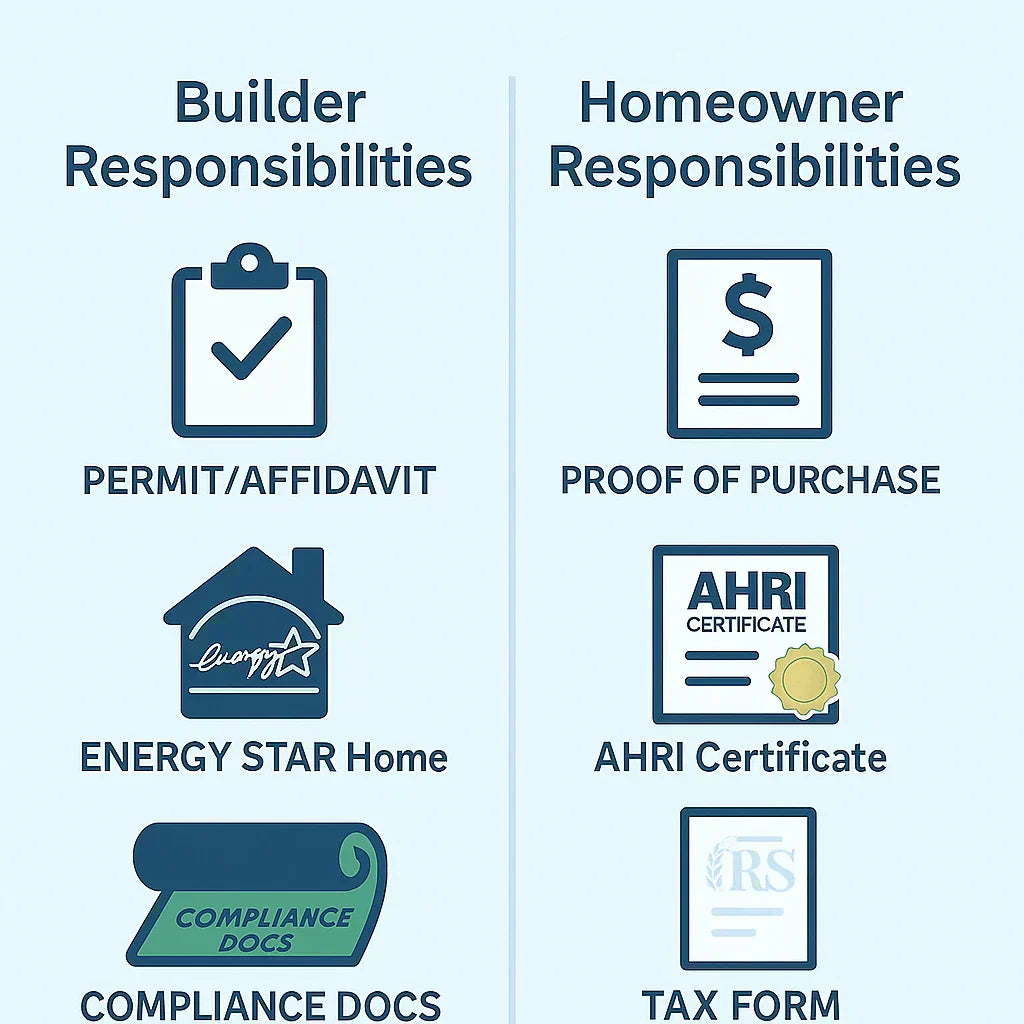Building a new home in 2025 is the perfect time to plan for energy efficiency. Unlike retrofits, where upgrades are limited by an existing structure, new construction lets you design your HVAC system, insulation, and home envelope to meet — and often exceed — the requirements for tax credits and rebates. But homeowners and builders alike often ask: What exactly qualifies for tax credits in new construction, and what paperwork do you need to prove it?
In this guide, I’ll break down the rules, documentation, and common pitfalls when it comes to claiming HVAC tax credits for new homes.
📘 For the complete incentive breakdown, start here: 2025 HVAC Tax Credits & Rebates Explained.
Federal Tax Credits and New Construction Homes
The Energy Efficient Home Improvement Credit (25C) is the most widely discussed residential tax credit in 2025. But here’s the catch: it applies primarily to existing homes where upgrades like heat pumps, central ACs, or insulation are added to replace or improve older systems.
For new construction, the Energy Efficient New Homes Tax Credit (45L) is the relevant program. Builders (not homeowners) typically claim this credit, but its benefits can flow to buyers indirectly in the form of more efficient homes and higher resale value.
According to the U.S. Department of Energy, the 45L credit offers up to $5,000 per new home that meets certain energy efficiency requirements. Homes must be certified to meet the ENERGY STAR New Homes Program or the Zero Energy Ready Homes Program.
👉 Bottom line: Builders get the credit, but homeowners benefit through lower energy bills and added value.
HVAC Equipment That Qualifies in New Homes
Not all HVAC equipment qualifies for credits in new construction. The IRS focuses on systems that meet strict efficiency benchmarks. According to ENERGY STAR’s official site:
-
Heat Pumps: Must meet ENERGY STAR Cold Climate standards.
-
Central Air Conditioners: Must meet ENERGY STAR Most Efficient or CEE Tier 1 levels.
-
Furnaces & Boilers: Must meet 97% AFUE for natural gas furnaces.
-
Water Heaters: Heat pump water heaters that meet ENERGY STAR efficiency.
Other upgrades like insulation, windows, and home energy audits are covered under 25C but only apply to existing homes. For new homes, it’s about whole-home efficiency certification.
Paperwork Builders and Homeowners Need
To successfully claim or benefit from new construction credits, documentation is key. Here’s what usually comes into play:
For Builders
-
Certification Report: Third-party verification that the home meets ENERGY STAR or Zero Energy Ready standards.
-
Builder Affidavit: Proof that the home complies with program requirements.
-
Permit and Inspection Records: Documentation from local building authorities confirming compliance.
For Homeowners
Even though you don’t claim the credit directly, you’ll want:
-
AHRI Certificate for HVAC Equipment (lists efficiency ratings for installed systems).
-
Energy Efficiency Documentation (from your builder or contractor).
-
Utility Rebate Forms (if local utilities offer incentives on top of builder-installed systems).
Pro tip: Keep these documents handy. They’ll matter if you later try to resell your home, refinance, or stack utility rebates with your efficient equipment.
For a clear checklist of common paperwork, the IRS Form 5695 instructions are worth bookmarking.
Common Misunderstandings About New Construction Credits
It’s easy to confuse 25C and 45L credits, especially when you’re building a home. Here are the most common mistakes:
-
Thinking homeowners get the credit directly. In new construction, the builder/developer claims 45L, not the homeowner.
-
Assuming all ENERGY STAR appliances qualify. Refrigerators, ovens, and other appliances don’t count — only specific HVAC and building systems tied to energy efficiency.
-
Mixing existing-home vs. new-home programs. 25C = retrofits; 45L = new homes.
The IRS 45L fact sheet provides a good breakdown of who can claim and under what circumstances.
Stacking Incentives: Rebates + Tax Credits
Even though homeowners don’t directly claim 45L credits, they can still take advantage of utility rebates and state-level incentives. Many states offer rebates for ENERGY STAR HVAC equipment in new construction homes, particularly when installed by certified contractors.
Examples:
-
California Energy-Smart Homes Program: Rebates for builders and sometimes homeowners.
-
Mass Save in Massachusetts: Rebates for high-efficiency HVAC systems in new homes.
-
NYSERDA in New York: Incentives for builders and homeowners investing in efficient heat pumps.
You can check available programs using the DSIRE database or ENERGY STAR’s rebate finder.
Why Planning Early Matters
The best time to align your build with tax credits is before construction starts. Here’s why:
-
Design choices lock in efficiency. Choosing duct layouts, insulation levels, and HVAC capacity during planning can make or break compliance.
-
Certification isn’t automatic. ENERGY STAR or Zero Energy Ready certification requires specific inspections and paperwork throughout construction.
-
Utility rebates may require pre-approval. Some programs won’t honor rebates if you don’t register before installation.
Homeowners should talk with builders early to ensure documentation will be provided. Builders should work with certified raters to avoid last-minute compliance issues.
The Bottom Line
For new homes, tax credits aren’t as simple as buying a new HVAC system and filing a form. The Energy Efficient New Homes Credit (45L) goes to builders, while homeowners benefit through efficiency, lower utility bills, and potential state or utility rebates.
The key is planning upfront, choosing certified equipment, and keeping all documentation organized. That way, you maximize both short-term rebates and long-term savings.
📘 Next up: Best Time of Year to Buy HVAC Equipment for Maximum Rebates
Alex Lane
Your Home Comfort Advocate







